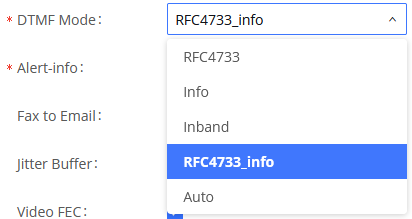DTMF via SIP INFO
It is not recommended to change this setting unless the PBX has issues with DTMF clamping resulting in duplicate DTMF. For details on how to configure this setting see here.
Issues
- This feature will not work if the only source of DTMF is SIP INFO.
- The DV2000 still relies on DTMF via the RTP packet to signal detection.
- All DTMF via RTP will be ignored. When this feature is enable it is assumed SIP INFO is the only source of DTMF.
PBX
Most PBX have a setting for the DTMF Mode and may be configured globally or on a per-extension basis. The DV2000 works best when the setting is set to RFC4733 or RFC2833.
In these examples you can see the different options for DTMF mode.
Grandstream UCM6302
In this example choosing info would cause the DV2000 to fail. The setting should be set to RFC4733_info.
FreePBX (Asterisk)
Troubleshooting
SIP Packet
This is an example of a SIP INFO packet seen in Wireshark.
The DTMF are located within the Message Body which contains the DTMF pressed along with the duration of that DTMF. In this example the caller pressed a 3 for 45 milliseconds.
DTMF
Some PBX send an actual * or # while others send a numerical value for these. The DV2000 will convert the values 10 and 11 to the correct DTMF, however it does not support A-D or Flash.
| DTMF | Signal Value |
|---|---|
| 0–9 | 0–9 |
| * | 10 |
| # | 11 |
| A–D | 12–15 |
| Flash | 16 |
DV2000
When the DV2000 receives this it will log it to the log representing the line the caller is on.
Detection
When the system detects the SIP INFO packet it will log the following. Typically the PBX will send a single packet for each DTMF the user pressed.
If this line is not in the log and you see the SIP INFO packet in wireshark, the system may not have detected this feature is on. Restarting the lines should resolve it.
MIME body line: 1 body [Signal=3 Duration=45]
Usage
When the system completes it's detection of DTMF it will log the following. This shows that it received the DTMF 1234 via an RTP packet and 1234 via the SIP INFO packet.
Success
RTP DTMF received [1234], SIP DTMF received [1234] after 6 ms
In this example you can see the PBX sent us duplicate DTMF via the RTP packet but we received the correct DTMF of 1234 via SIP INFO.
RTP DTMF received [12234], SIP DTMF received [1234] after 6 ms
Failure (no info)
In this case we received 1234 via RTP however the PBX never sent us a SIP INFO packet. In this case it would also have never logged the packet above containing the MIME body.
RTP DTMF received [1234], SIP DTMF received [] after 6 ms


